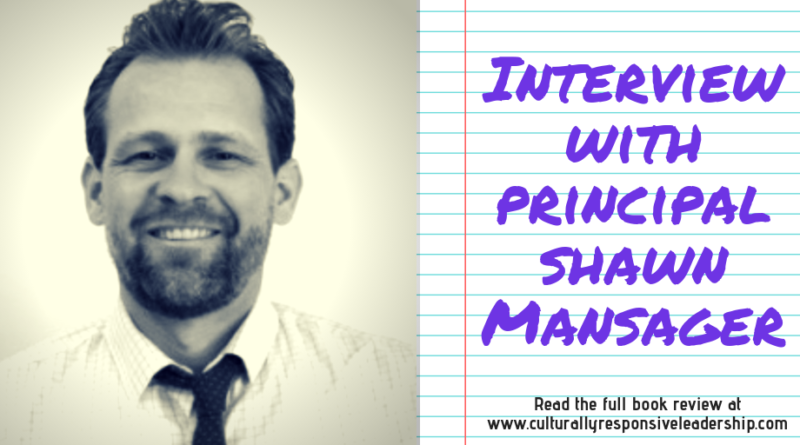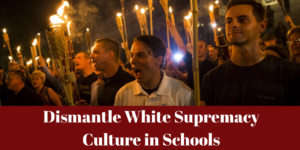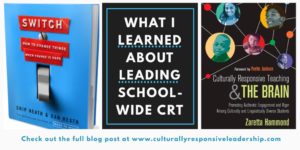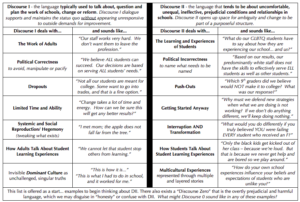How does White Fragility inform your leadership? – Principal Interview with Shawn Mansager (Pt. 3/4)
White fragility talks about understanding how your whiteness informs your experience and perspective. Much of this applies to interactions between teachers and students, but what if you are a leader, a white leader? What can you do? How can culturally responsive leadership support you? Here’s a principal’s perspective on pushing through white fragility.
This is the third of 4 parts.
Part 1: Background knowledge about the book
Part 2: What Leaders can do about White Fragility
Part 3: A White Leader’s reflection on addressing White Fragility
Part 4: What schools without White Fragility could look like
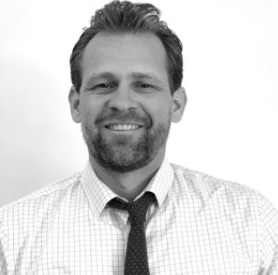
Responses below come from an accomplished and successful Principal, in the San Francisco Unified School District. As a white leader, Shawn Mansager, in his 4th year at John Muir Elementary School, exemplifies what Culturally Responsive Leadership can look like. His school work around improving math scores, using Lesson Study was just featured in the LA Times. Currently, his staff is working on Culturally Responsive Teaching and Racial Equity.
Q1: How do you approach dealing with white Fragility?
It was not hard for me to own my skin privilege once it was revealed to me at the tender age of 33. A decade ago, I attended a week-long workshop with SFCESS (San Francisco Coalition of Essential Small Schools). During this week, Greg Peters and his staff led a racially mixed group of educators in race conversations. One thing that became quickly apparent, was that the majority of white folks in the room had never had to talk about race or explore whiteness. There were many white tears and denials, as well as, moments of truth and understanding. It was truly an awakening for me.
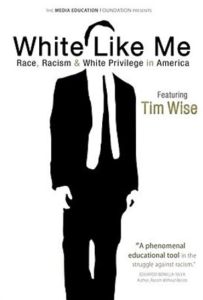
As I delved into literature, lectures, and conversations, it became pretty obvious that white people solely created the legacy of racism and white supremacy. And since racism is supported daily through overt acts or acquiescence and silence by white people, it also becomes the sole responsibility of white people to eradicate racism. Books such as White Like Me, The Racial Contract, Why are All the Black Kids Sitting Together in the Cafeteria, and How the Irish Became White which opened up a new lens for me to view the world. I also realized much of my college literature courses did not include author’s of color, so I educated myself with fantastic literature like Toni Morrison’s (The Bluest Eye), Ralph Ellison (Invisible Man) and Zadie Smith (White Teeth) and Gabriel García Márquez (One Hundred Years of Solitude). These books helped open up a new schema with how I viewed the world.
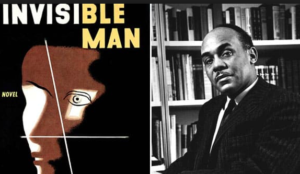
So how is it that a 33-year-old white man got through a credential program and 6 years of college without one conversation about race?
Well, I’m not unique.
This is really common for us white people. I quickly came to understand that the majority of white people, including family and friends, really don’t want to talk about race and skin privilege and have been shielded by our system from birth from these conversations. So when I started pointing out our privilege to other whites, reactions ranged from bemusement, curiosity to visceral anger.
Through trial and error, I have learned that my approach is a key ingredient. Tema Okun’s piece From White Racist to White Anti-Racist: the Lifelong Journey helped me understand that becoming a White Ally is a lifelong process. I have had conversations with white family and friends where I come in with a hammer of matter of fact statements and statistics.
This rarely goes well.
Other times, I have remained silent due to fear of damaging relationships. And on a rare occasion, I am able to shift a person’s thinking through intentional questioning and conversation. I am not highly concerned with the feelings of other white people when it comes to pointing our skin privilege; however, I want to be more intentional in bending their thinking in order to get them to start interrupting white supremacy.
Robin DiAngelo helps us understand the disequilibrium white people go through when we suddenly realize we have lived lives of unearned privilege. She shares:
“There is a difference between agreement and understanding: When discussing complex social and institutional dynamics such as racism, consider whether “I don’t agree” may actually mean “I don’t understand.”
It is important for us white people to not have knee-jerk reactions when we have our moments of cognitive dissonance. We need to listen, reflect, learn and take action. We also need to understand that People of Color are often not afforded the same mistakes that we are allowed to make on a daily basis on account of our skin privilege.
Q2: Have there been times when White Fragility prevented growth or change from happening at your site?
White fragility is why many of our children of color are being failed in schools. The inability of white educators to self-reflect on their own behaviors is a major impediment to the academic success of our children of color. Whether it is our families distrust of the system or a teacher’s rigid response to a Black child calling out in the middle of a lesson, we are a major player in building roadblocks or bridges. Eighty percent of the teaching force is white. When Brown versus the Board of education was enacted, many Black teachers were fired and replaced by white teachers. Their is a legacy in this country of the systematic destruction of Black and Brown communities. Public education was one front.
Many times, we white educators take things personally and are unable to look past the moment (White Fragility). I’ll give an example of my own incident with a Black mother several years back. Her son had gotten into a physical fight. When talking to the mom, I was defensive, had a closed body and was not making eye contact due to my perception that the mom was making excuses for her son’s behavior. She left angry with her son and a colleague of color pointed out after she left that my approach did not help. She did not send her son to school for a few days.
My white fragility got the best of me.
I had to later call this family, apologize for my reaction and rebuild that bridge.
I believe the majority of white educators are good people, and I have seen over and over again, white “liberal” educators not wanting to talk about race, but rather class, gender and sexual orientation. Of course, these topics are also necessary conversations (i.e. intersectionality), and it is hard for an underpaid and under-respected teacher to think that they may be supporting a racist system through their own daily actions. I have found white fragility can take over an entire meeting and create a very negative atmosphere. It takes intentional moves at this moment from leaders to steer the conversation back to productive struggle.
Through self-reflection and intentional work on our daily relationships, white people can create systematic change. Site leaders have to intentionally create opportunities for white educators to explore their identities and to help them understand the systematic processes that uphold white supremacy culture in our schools.
We cannot take things personally, and we need to be better listeners and reflective about our daily thoughts and interactions with our families, students of color and our colleagues of color. In my fifteen years in public education, I have seen many successes in building strong relationships and bonds between white teachers and their students of color and families. Change is possible with a commitment to justice and reflective leadership.
Q3: What tools can white leaders do to mitigate White Fragility?
Currently, the approach I am using with my staff is to get them to focus on creating classroom environments that support independent learning. Many of our students of color have become dependent learners due, in my opinion, to deficit model thinking and the teacher’s inability to create classrooms that are Socratic in nature and culturally responsive to the children they serve. Without intentional reflective teaching, we teach like we were taught. The majority of our university professors were lecturers, not facilitators of learning.
This model fails many of our students of color.
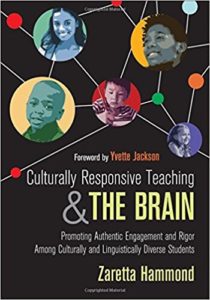
We are currently using Zaretta Hammond’s Culturally Responsive Teaching and the Brain as a guide. Her Ready for Rigor framework recognizes that racism and white supremacy are key factors in creating the opportunity gap, and she places student thinking and learning at the center of the work teachers need to do.
Zaretta shares:
“In a nutshell, culturally responsive teaching is about helping culturally and linguistically diverse students who have been marginalized in schools build their skill and capacity to do rigorous work. The focus isn’t on motivation but on improving their brainpower and information processing skills. Motivation is only a small part of it.”
I am working with coaches and our Instructional Leadership Team (ILT) on weaving articles and conversations into our professional development cycles that deal with culturally responsive teaching. I have found that just having the race and privilege talk has little impact on the classroom practice.
This conversation often becomes about the adults and feelings being hurt (White Fragility).
This is why we are focusing the conversation currently on how children are learning and participating in the classroom. Yes, this at first feels like the path of least resistance, and I am seeing positive growth and changes in practice in many of the classrooms. This doesn’t mean we ignore these conversations, but we recognize that this is a process, and by seeing success in the classrooms, we can build equity platforms. These platforms then create stability for us to have more courageous conversations.
The biggest tool I use at my site is leading by example. I own my privilege as a white cisgender male. I share examples of my own foibles along the way. I recognize that despite the work I have done on myself, I still have my moments of white fragility. When I make mistakes, I work on owning them, apologize and continue the work. I don’t expect anyone to accept my apology. This work is a life-long practice and making mistakes is part of the process of growth.
As a leader, we have to be courageous and have those conversations. I used to think that I needed to remove the people from my life that did not agree with my standpoints on racism, and am now realizing that this is the path of least resistance. I have to avoid the self-righteous attitude and help guide other white people to a better understanding of what it means to be an ally. This takes patience, which I am good at on some days and not so good on others.
This also applies to replacing educators in the classrooms who are not meeting expectations. I have learned over the years that spots are often filled with a new teacher and the same results are produced. At times this is necessary; especially if the lack of reflection on the educators part is keeping change from happening. But in my opinion, until see we systematic changes in the hiring process and teacher pay is increased, we will have smaller pools of candidates. We must set up intentional structures to dismantle white supremacy thinking and build a culture at our sites that encourage courageous conversations.
We must find our allies at sites that can help lead the change. Individualism is a white norm and can lead to the “lone cowboy on the plain” mentality. We must collect others who are willing to do the work and provide them space and time to work on leadership. We do not do this work alone. This work can lead to depression and loneliness which does not help the cause and emboldens white fragility.
Q4: How do you address white Fragility as a white leader?
I’ve struggled as a principal on this topic. As a teacher, I felt it was easier to speak out about skin privilege. As a white, cisgender in a position of power, I feel I have to be more strategic due to the union and teachers’ feelings of being in a system that does not support teachers.
In the interview process, I do name that it is important for white educators to be reflective about their skin privilege. I use these comments as a barometer to see their reaction. I have had many private conversations with white teachers about Discourse 1 versus Discourse 2 when talking about families and children. I also use my Friday Bulletin to share articles and raise concerns and areas for our site to reflect concerning systemic racism.
I have been called out for my own missteps and try to publicly acknowledge and apologize.
Principal’s are not superhumans who always say the right things at the right times.
Building equity driven communities is a messy process. We must be able to wade through the messiness while keeping student success at the center. Overall, what I strive for at my site is what Tema Okun describes as a “Community of Love and Resistance.” When I first started at my site, I was asked to suspend students quite regularly and was described as “soft.” Presently, I am rarely asked to suspend and have teachers ask that we find alternatives for consequences. Almost every teacher at our site has a mentee, and I feel generally care for their students of color.
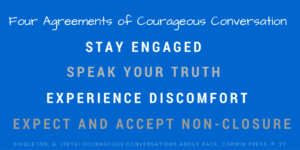
What we need is for white educators to create communities that want to explore how skin privilege and white supremacy play out in daily interactions with their students and families. This work cannot be relegated to a few Professional Development sessions. It is daily work that, frankly, will not end in our lifetimes. One of Glenn Singleton’s norms for having courageous conversations about race is: experience discomfort.
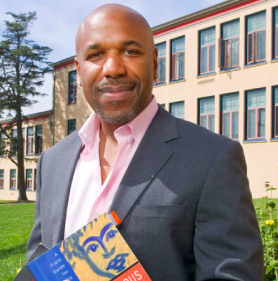
So let’s expect discomfort and push through it. For our students.
Much love for the work Shawn is doing at John Muir, and his willingness to model vulnerability. This work is about connecting and harnessing our collective strength. That is culturally responsive leadership.
Make sure you check out Part 1 and Part 2 of this series. If you are engaged in this topic, let’s connect on Twitter (twitter.com/trussleadership) and keep the conversation going. I know there are many leaders out there working towards racial equity and the success of students of color. I’d love to hear what’s on your mind and what questions you have.
Part 4 IS IN THE WORKS! But may take a few weeks. I will be exploring the question:

